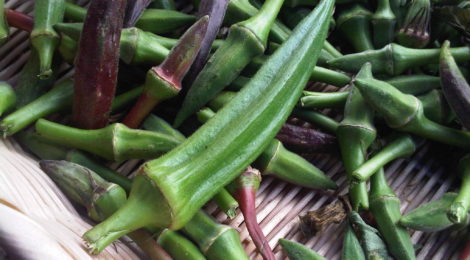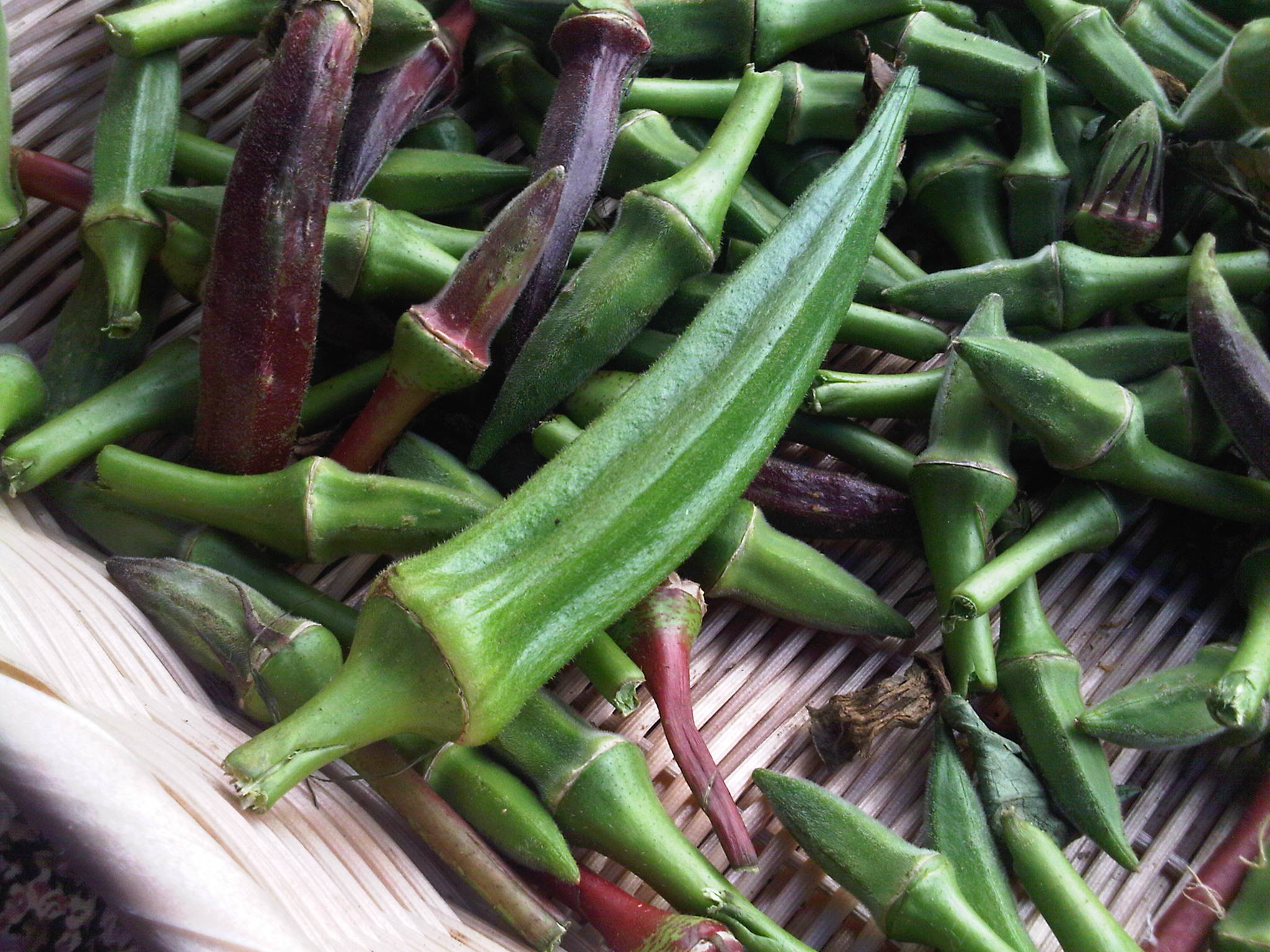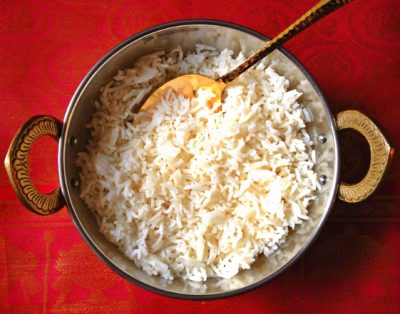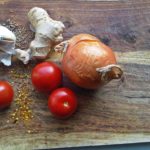
Everybody Loves Okra?

Fresh okra at New York City’s Union Square Farmer’s Market
Okra is one of those things people either love or hate. If you’ve only ever had it frozen then boiled OR fresh then boiled, the squishy, slimy consistency can be a turn-off. However, if prepared well it can be downright crave-able. Like certain things that are an acquired taste at first (including tofu, in my humble opinion) okra is often more appealing when it’s deep-fried. Or stewed for a long time in a hearty New Orleans gumbo with tomatoes, bacon drippings, lump crabmeat and shrimp. Or thin, crispy discs of pan-fried okra folded into a spicy, andouille sausage jambalaya dotted with celery and herbs. In North America, we usually associate okra with Cajun cuisine or the southern United States.
My first memory of okra is from summer vacations to Bangalore, India as a child. I remember my aunts asking me if I wanted to eat ‘lady fingers’ which, at 8 years old, I found funny and confusing at the same time. My friend Alda is from northern Spain and never saw it growing up, as it’s neither native to that part of Europe nor is it used in Spanish cuisine. Alda loves okra so whenever she comes over for dinner, I try to make it for her. This sparked an interesting dinner party conversation last year, as we all wondered about where okra first originated, since many only remembered discovering it as adults while others had memories of okra dishes their aunts and grandmas would make in the home country.
Like curry, the origins of okra are unclear and under debate. It seems most likely to have come from South Asia or North Africa. Today you will find it in dishes in India, Pakistan, Malaysia, Vietnam, Japan, the Middle East, Africa, the Caribbean, North America, and Brazil. According to Wikipedia, if okra did originate in South Asia, it may have traveled across the Red Sea to the Arabian Peninsula as early as 1216 when locals were eating it in Egypt; it then spread throughout the Mediterranean and was introduced to the Americas via the slave trade, showing up in Brazil in 1658 and Suriname in 1686; apparently Thomas Jefferson noted okra growing in Virgina by the 1780s. Gotta love encyclopedias. I’m going to donate some $ to Wikipedia today. Come on people, we all use it at some point or another.
Here is one of my favorite okra dishes from Madhur Jaffrey, which you can make in 15 minutes. Most of the time is taken up by thinly slicing the raw pieces lengthwise before you cook it, really. That’s the real secret to this recipe, slicing it as thinly as possible so when it hits the pan, the oil seals in the spices and brings out the best part of its natural taste and it somehow removes the slime quickly.
What I like about this dish, is the okra is not deep-fried, thereby healthier for you, but is pan-fried, so it’s the best of both worlds — the finished dish still retains the the herbaceous, freshness of the tender vegetable, while elevating it by fast frying it in oil with thinly sliced onions and dry spices — coriander, turmeric, dry red chilli, and some salt. I love how the little white pods burst with blackened, roasted, turmeric-onion flavors in my mouth. I want some now. I’ll call Alda and see if she wants to come have dinner with us tonight.
Madhur Jaffrey’s Okra with Onions (very slightly adapted)
Serves 4
Ingredients
- 2 tablespoons canola oil
- 12 ounces fresh okra, topped and tailed, then sliced in quarters lengthwise for long, thin strips*
- 1 medium onion, thinly sliced into rings
- 1 teaspoon salt
- 1/4 teaspoon ground turmeric
- 2 teaspoons ground coriander
- 1/2 teaspoon ground red chilli powder or cayenne powder
- 1/4 cup fresh cilantro, finely chopped (before serving)
Preparation
- Pour the oil into a large, preferably nonstick skillet and set over medium heat. Drop one sliver of okra in there, when it starts to move you will know the oil is ready.
- Put in the okra, ideally in a single layer. Stir and fry for 10 minutes, or until the okra is very lightly browned on all sides. Add the thinly sliced onions. Stir and cook for another 5 minutes, until the onions also begin to brown.
- Add the coriander, chilli powder, salt, and turmeric and combine well to coat all the pieces of okra and onion evenly.
- Reduce the heat to low and continue stirring for another 5 minutes. Taste for a balance of seasonings and salt and sprinkle the cilantro on top before serving.
Tips & Tricks
Keep these things in mind to ensure your okra doesn’t become mushy or slimy:
- Fresh versus frozen. Never use frozen okra for this dish, only fresh. Believe me, I’ve tried it. Doesn’t work.
- Wash BEFORE you cut it. Be sure to wash the okra and then let it dry completely before you slice or chop — it must be completely dry! When I first started cooking after college, I would slice the fresh okra in rounds and then wash them in a colander with water. Big mistake. Huge. Slime takes over in a matter of minutes, and it will stick to your hands, kitchen towel, and counter.
- Don’t let any water drip into the skillet. Make this dish with the skillet uncovered; if the recipe does call for using a cover, don’t let any of the water or condensation from the lid drip into the okra.







This is a gorgeous Okra Dish! It is on the Curry Bible. So easy to prepare. It has all this lovely smoky flavour from dry frying with Okra. I Cooked it yesterday evening as a side vegetable with another Madhur recipe for prawn as shown on PBS. But since no fresh prawn available in market, we used Monkfish instead.
Bon Apetit from London
Lee